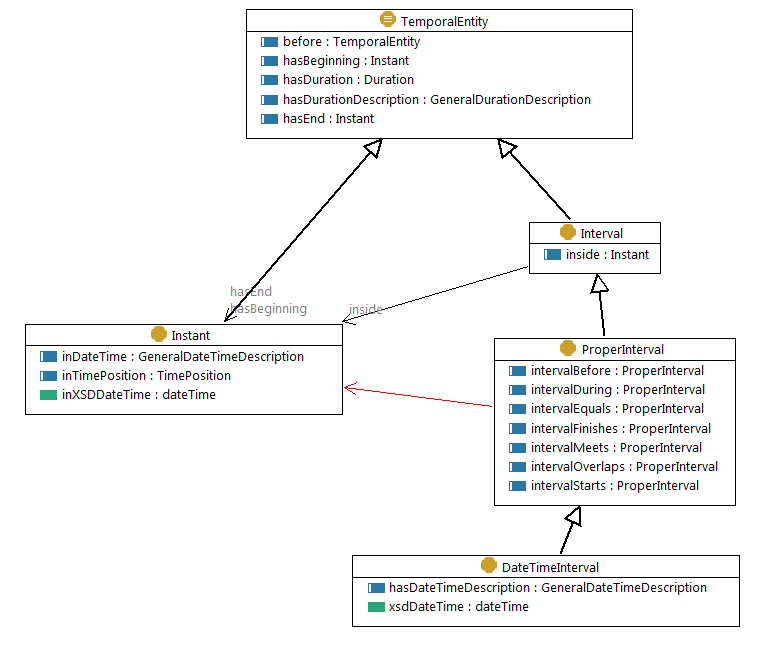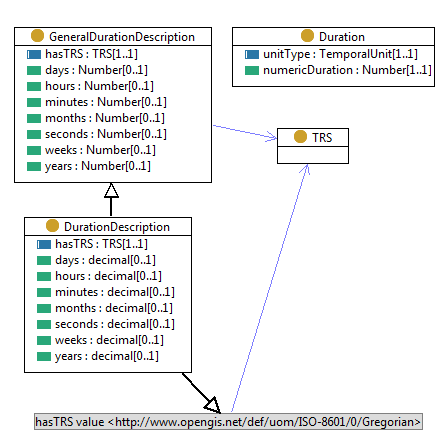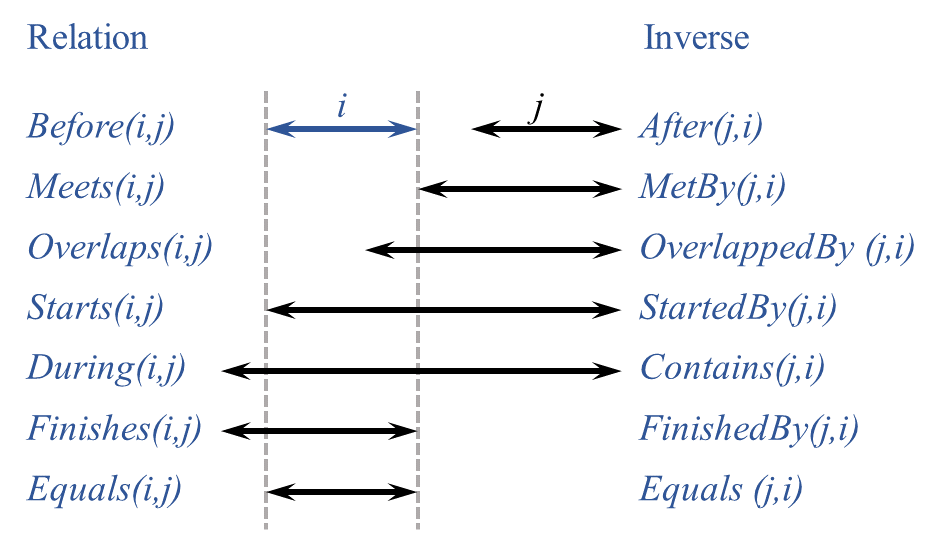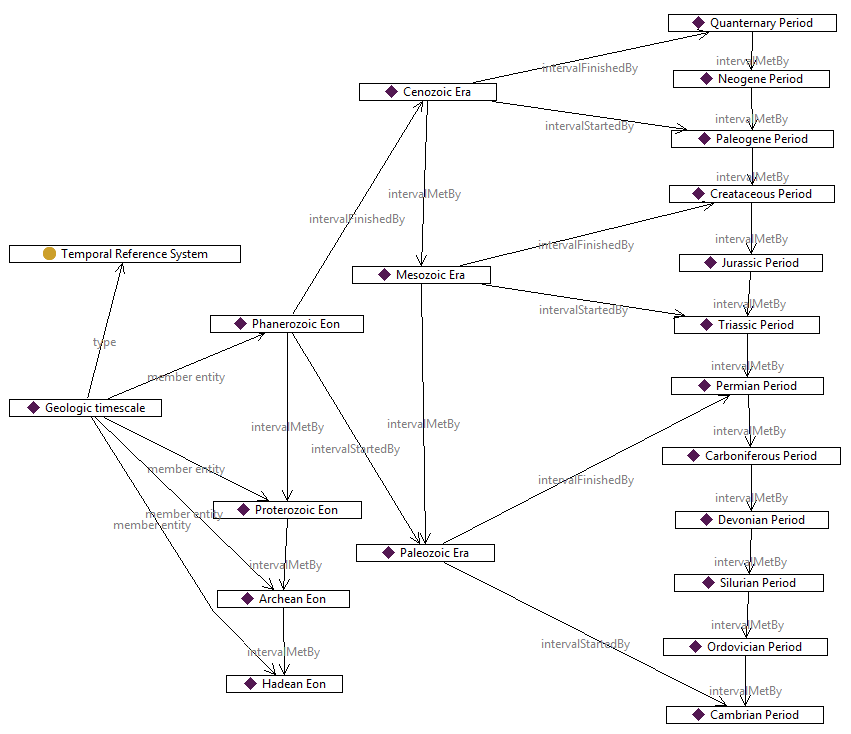7.7 Web commerce applications
Congo.com and Bravo Air are examples from the OWL-S 0.9 draft release [OWL-S]. Congo.com is a fictitious book-selling service site, and Bravo Air is a fictitious airline-ticketing service site. These examples demonstrate how the time ontology can be used to support OWL-S, including use cases for defining input parameters and (conditional) output parameters.
In the profile of the Congo.com example (i.e. CongoProfile.owl), for example, our time ontology is currently used for describing the input parameter CreditCardExpirationDate:
profile:CreditCardExpirationDate
a profile:ParameterDescription ;
profile:parameterName
creditCardExpirationDate ;
profile:restrictedTo
:Instant ;
profile:referTo
congoProcess:creditCardExpirationDate .
The namespace “time” points to the location of the OWL code for the time ontology. In this example Instant is used to describe CreditCardExpirationDate, because the expiration date is actually an instant -- the midnight, of the day the credit card expires.
In the Bravo Air example, our time ontology can be used to describe the existing input parameters, DepartureDate and ArrivalDate. We will change this to the more appropriate DepartureTime and ArrivalTime. We can define DepartureTime in the profile of the Bravo Air example (i.e. BravoAirProfile.owl) as:
profile:DepartureTime
a profile:ParameterDescription ;
profile:parameterName
DepartureTime ;
profile:restrictedTo
:Instant ;
profile:referTo
ba_process:outboundDate_In .
DepartureTime is defined as Instant. With this definition, as we discussed in the previous datetime description section, an instance of DepartureTime can has either an inXSDDateTime property/relation pointing to a specific value of XML Schema datatype dateTime, say 2006-01-01T10:30:00-5:00, or an inDateTime object-property/relation pointing to an instance of DateTimeDescription class specifying a specific time, say 10:30am EST on 01/01/2006, Sunday. It would be the user’s decision to define the time in either way based on the trade-offs discussed in the previous section.
(Conditional) Output Parameters
In fact, there is much more that our time ontology can do to support OWL-S. In the Congo.com and Bravo Air examples, the time ontology is not used for any output parameters. However, in the real world many service outputs are time-related. For example, in the Congo.com example we can add two outputs that are very common in real world book-selling sites: process time and delivery duration.
Adding a ProcessTime output parameter
ProcessTime is a conditional output parameter that specifies how long before the book will be ready for delivery, say, 24 hours, which depends on whether the book is in stock. In this use case, the process time is returned only if the book is in stock. It can be defined in the process model of the Congo.com example (i.e. CongoProcess.owl) as:
:ProcessTime
a owl:Class ;
rdfs:subClassOf :Interval .
:fullCongoBuyProcessTime
a rdf:Property ;
rdfs:subPropertyOf process:output ;
rdfs:domain :FullCongoBuy ;
rdfs:range
[ a owl:Class ;
rdfs:subClassOf process:ConditionalOutput ;
rdfs:subClassOf
[ a owl:Restriction ;
owl:allValuesFrom :BookInStock ;
owl:onProperty process:coCondition
] ;
] ;
rdfs:subClassOf
[ a owl:Restriction ;
owl:allValuesFrom :ProcessTime ;
owl:onProperty process:coOutput
] .
ProcessTime is defined as an interval, rather than a duration. As discussed previously, in our time ontology durations are properties of intervals. Thus to talk about a duration, i.e. a quantity of time, an interval must be defined first. This approach may look roundabout at first glance. However, the process time is not purely a quantity of time; it has a location on the time line. The beginning of the process time is the time the user places the order, and the end of the process time is the time the order is shipped out. An advantage of defining ProcessTime as an interval is that if the relationship among the order time, the shipping time, and the process time is known, any one of them (e.g. the shipping time) can be computed from the other two (e.g. the order time and the process time) by temporal arithmetic.
Adding a DeliveryDuration output parameter
DeliveryDuration is a conditional output parameter that specifies how long it will take for the customer to receive the book after it is shipped out, which depends on the delivery type the customer selects. As defined in the process model of the Congo.com example (i.e. CongoProcess.owl), the current delivery types are FedExOneDay, FedEx2-3day, UPS, and OrdinaryMail.
To add this output parameter may seem similar to the above ProcessTime example. However, since an instance of Condition is a logical formula that evaluates to true or false (see the comment with the definition of Condition [PR-OS]), DeliveryType cannot be directly used as a condition to determine the delivery duration. Thus one property and one condition are defined for each delivery type.
DeliveryDuration is defined with two boundaries: one minDeliveryDuration and one maxDeliveryDuration. For example, an order with the FedEx2-3day delivery type takes 2 to 3 days, so its min delivery duration is 2 days, and its max delivery duration is 3 days. For the delivery duration of the order with FedExOneDay delivery type, the min and max delivery duration will both be 1 day. We can define DeliveryDuration in the process model of the Congo.com example (i.e. CongoProcess.owl) as:
:DeliveryDuration
a owl:Class ;
rdfs:subClassOf
[ a owl:Restriction ;
owl:cardinality 1 ;
owl:onProperty :maxDeliveryDuration
] ;
rdfs:subClassOf
[ a owl:Restriction ;
owl:cardinality 1 ;
owl:onProperty :minDeliveryDuration
] .
:maxDeliveryDuration
a rdf:Property ;
rdfs:domain :DeliveryDuration ;
rdfs:range :Interval .
:minDeliveryDuration
a rdf:Property ;
rdfs:domain :DeliveryDuration ;
rdfs:range :Interval .
Both minDeliveryDuration and maxDeliveryDuration are defined as properties of DeliveryDuration. For the same reason discussed for the process time example, both properties use Interval as their ranges. The cardinality of 1 for both properties in the definition of DeliveryDuration indicates that an instance of DeliveryDuration must have one and only one property value for minDeliveryDuration and maxDeliveryDuration respectively. For example, in order to define delivery duration for FedEx2-3day, we have to first define a condition of FedEx2-3day being selected:
:FedEx2-3dayCondition
a owl:Class ;
rdfs:subClassOf process:Condition .
Then we define an output property, called deliverySelectFedEx2-3day that is conditional on FedEx2-3dayCondition defined above:
:deliverySelectFedEx2-3day
a rdf:Property ;
rdfs:subPropertyOf process:output ;
rdfs:domain :SpecifyDeliveryDetails ;
rdfs:range
[ a owl:Class ;
rdfs:subClassOf process:ConditionalOutput ;
rdfs:subClassOf
[ a owl:Restriction ;
owl:allValuesFrom :FedEx2-3dayDuration ;
owl:onProperty process:coOutput
] ;
rdfs:subClassOf
[ a owl:Restriction ;
owl:allValuesFrom :FedEx2-3dayCondition ;
owl:onProperty process:coCondition
] .
This definition says that deliverySelectFedEx2-3day is a conditional output, and if FedEx2-3dayCondition is true, an instance of FedEx2-3dayDuration class will be the output. FedEx2-3dayDuration is not defined yet. In order to define it, we have to define its min delivery duration, i.e. 2 days, and max delivery duration, i.e. 3 days. Since the range of minDeliveryDuration and maxDeliveryDuration is Interval, intervals with specific durations need to be created first. For FedEx2-3dayDuration, we need to define Interval2Days and Interval3Days first as follows:
:Interval2Days
a owl:Class ;
rdfs:subClassOf :Interval ;
owl:subClassOf
[ a owl:Restriction ;
owl:hasValue P2D ;
owl:onProperty :durationDescriptionDataType
] .
:Interval3Days
a owl:Class ;
rdfs:subClassOf :Interval ;
owl:subClassOf
[ a owl:Restriction ;
owl:hasValue P3D ;
owl:onProperty :durationDescriptionDataType
] .
These two definitions use durationDescriptionDataType, a relatively simpler duration property of Interval using the XML Schmea datatype duration as its range. P2D and P3D are values of the XML Schema datatype duration, meaning 2 days and 3 days.
Finally, FedEx2-3dayDuration restricts the value of minDeliveryDuration and maxDeliveryDuration to class Interval2Days and Interval3Days respectively as follows:
:FedEx2-3dayDuration
a owl:Class ;
rdfs:subClassOf :DeliveryDuration ;
rdfs:subClassOf
[ a owl:Restriction ;
owl:allValuesFrom :Interval3Days ;
owl:onProperty :maxDeliveryDuration
] ;
rdfs:subClassOf
[ a owl:Restriction ;
owl:allValuesFrom :Interval2Days ;
owl:onProperty :minDeliveryDuration
] .
Properties to output delivery durations when the user selects other delivery types (FedExOneDay, UPS, and OrdinaryMail) can be defined similarly.





